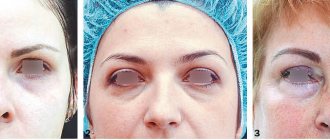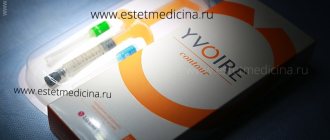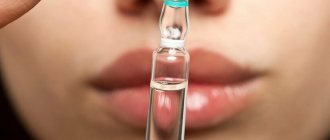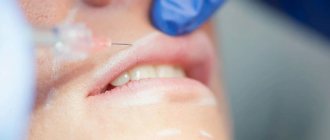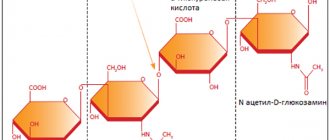In the practice of an aesthetic medicine doctor, the number of allergic patients grows exponentially every year. Increasingly, their ranks include people who have not previously suffered from a specific reaction of the body. Why does this happen and what to do in this situation?
Allergies are similar to phobias, according to immunologist Dr. Michael Levi, who was awarded an IHA research award for his research into the immune system. Dr. Levy argues that under stress (e.g. psychological stress, work, family, etc.), the immune system is triggered in a similar way to the mechanism of phobic reactions and becomes so excited that it begins to attack its own body, although no danger threatens it1. That is why in megacities and growing cities, the incidence of allergies among the adult population is growing at a rapid pace, since the immune system is constantly provoked by stress factors.
Facts and statistics
- Allergies are classified as chronic diseases. In terms of prevalence, it is in “honorable” fifth place.
- According to research results, up to 40% of Russians have already encountered at least once manifestations of a “rebellion” of the immune system.
- The probability that a child of healthy parents will be allergic is about 15%, if the disease existed in the family, then the chances increase to 50%, but if the parents directly experience manifestations of a specific reaction, then allergists are confident that in 80% of cases the disease will be transmitted through inheritance.
- Doctors estimate that 90% of the population has a predisposition to allergies. This means that the reaction can occur at any time if several provoking factors coincide.
Myth 4. Hyaluronic acid is only used to plump lips and fill wrinkles.
This is wrong. Treatment with hyaluronic acid is one of the most popular areas in aesthetic medicine.
Examples of procedures:
- oval face modeling;
- non-surgical nose correction;
- mesotherapy;
- treatment of symptoms of vaginal aging, in particular with excessive dryness of the mucous membrane;
- enlargement of the labia in intimate plastic surgery;
- injection reshaping of the clitoris;
- rejuvenation of different parts of the body;
- treatment of some forms of urinary incontinence, etc.
Hyaluronic acid injection
A few words about physiology
The skin is an organ in contact with the external environment and capable of triggering many reactions to protect the body from damaging factors.
There are two types of immunity: innate and acquired.
The two main types of adaptive immune cells in the epidermis are keratinocytes and Langerhans cells. Neutrophils, macrophages and dendritic cells play a very important role in the innate immune system. When a foreign substance enters the body, innate immune cells are activated through the pattern recognition receptor (TLR) system. Activated innate immune cells produce cytokines and inflammatory mediators that influence the acquired immune system.
Activation of immune cells is one of the most important mechanisms for protecting the skin from antigens and toxins. Paradoxically, the defense mechanism easily becomes the cause of breakdown, and activation of immune mechanisms can be accompanied by inflammatory processes that result in the development of adverse events or complications in response to the introduction of fillers 2.
In cosmetology practice, the doctor has to pay more and more attention to collecting anamnesis and assessing the risks of any intervention in the body. And the statistics make you think.
According to research, in Russia in 2022, cosmetic services were provided using about 2,000,000 ml of dermal fillers.
Hyaluronic acid dermal filler should always be considered an “implant.” Once in the patient’s body, the filler can cause either a pronounced immediate allergic reaction or cause delayed manifestations of this process .
In pathophysiology, such reactions are usually called mechanisms of development of allergic reactions of delayed and immediate type hypersensitivity3.
Immediate hypersensitivity (IHT) is caused by antibodies against allergens. It develops a few minutes or hours after exposure to an allergen: blood vessels dilate, their permeability increases, itching, rash, and swelling develop. The late phase of HNT is complemented by the action of eosinophil and neutrophil products.
Delayed-type hypersensitivity (DTH) refers to type IV allergy (according to Jell and Coombs). It is caused by the interaction of the antigen (allergen) with macrophages and Thl lymphocytes, which stimulate cellular immunity. Develops a few days after exposure to an allergen: compaction and inflammation of the tissue occurs as a result of its infiltration by T-lymphocytes and macrophages4.
A cosmetologist must remember that all the main hyaluronic acid-based fillers used in practice are distinguished by the potential for the release of inflammatory mediators. The interleukins and chemokines released during this process can provoke an inflammatory reaction in tissues.
In August 2015, independent researchers conducted a retrospective analysis of patients who underwent 3D facial modeling with Juvederm Voluma between February 1, 2009 and September 30, 2014. Over 68 months, 4,702 procedures were performed using 11,460 ml of filler. In 23 patients, the formation of nodules at the injection sites was noted. The median time from injection to response was 4 months and time to resolution was 6 weeks. Nine of 23 patients (39%) had an identifiable immunological trigger 5.
Myth 2. Allergies to hyaluronic acid are common.
You can find a lot of conflicting information on this topic on the Internet. But you need to understand that hyaluronic acid is produced naturally in the body of every person, so an allergy to that substance is rather nonsense, although it is not 100% excluded.
It is worth considering that many drugs, such as creams with hyaluronic acid, contain additional ingredients, so if an allergy occurs, it is not a fact that it was caused by the main component. In addition, natural redo hyaluronic acid is sold in its pure form; counterfeits are much more common. Such drugs can even cause allergic shock.
Do the quality and production technology of fillers affect the risk of developing allergic reactions?
In 2008–2009, at the Center for Plastic and Aesthetic Surgery (Cologne, Germany), a comparative study of tissue response to intradermal injection of various materials for injection contour plastic surgery based on stabilized hyaluronic acid and collagen was conducted6.
The study compared popular hyaluronic acid fillers: Belotero® Balance (Basic), Juvéderm® ULTRA 3, Restylane®, Surgiderm® 24 XP, and Teosyal® Global Action, as well as deeper injection fillers 30 HV, Restylane® Perlane, Surgiderm® 30, and Teosyal® Deep Lines, as well as collagen-based fillers.
The study included four patients (ages 39–69 years) who were scheduled to undergo abdominal liposuction. All volunteers were injected with 11 different fillers (0.2 ml each) into the abdominal skin 30 days before surgery.
On the 14th and 30th days after implantation, tissue samples were taken from the marked areas under local anesthesia. To detect possible acute reactions, tissue samples were taken from one patient four hours after the injections.
Further results were assessed on the 14th and 30th day after injection ( Fig. 1, 2
).
Fig.1.
Hematoxylin-eosin staining, x 20, E - epidermis, LY - lymphocytes, PZ - plasmacytes, EG - eosinophilic granulocytes, FM - foreign material.
Surgiderm® 24XP
Severe chronic inflammation, infiltration of lymphocytes and plasma cells LY, PZ.
Juvéderm® 30HV
Mild or moderate chronic inflammation: LY, PZ, EG.
Teosyal® Deep Lines
Pronounced chronic inflammation: LY, PZ, EG.
Belotero® Basic
There is no histomorphological inflammatory reaction.
Fig.2.
Hematoxylin-eosin staining, x 20, E - epidermis, LY - lymphocytes, PZ - plasmacytes, EG - eosinophilic granulocytes, FM - foreign material.
Juvéderm® 30HV
Mild or moderate chronic inflammation, increased levels of lymphocytes, plasma cells and eosinophils: LY, PZ, EG.
Restylane® Perlane
Severe chronic inflammation, significant infiltration of lymphocytes, plasma cells and eosinophils: LY, PZ, EG.
Teosyal® Deep Lines
Pronounced chronic inflammation, abnormally pronounced infiltration of lymphocytes and plasma cells: LY, PZ, EG.
Belotero® Intense
There is no histomorphological inflammatory reaction. Uniform distribution of material.
The results of the experiment showed no signs of an inflammatory reaction in response to the introduction of only two HA-based fillers - Belotero® Balance and Belotero® Intense ( Fig. 1, 2
), while all other fillers showed evidence of a chronic inflammatory response. There were no significant differences between samples taken 14 and 30 days after administration.
Myth 1. Hyaluronic acid is only suitable for older women
Thanks to its many benefits, hyaluronic acid can be used even before visible wrinkles appear. Therefore, cosmetics with hyaluronic acid (in a certain amount), if the skin condition requires it, can be used even in adolescence.
The properties of hyaluronic acid include water-binding ability, so it works especially well on dry and dehydrated skin. After using it, the skin becomes pleasant to the touch and less rough.
Hyaluronic acid is also used in injections. Such procedures are often needed by older people or those who have noticed signs of aging of the skin and mucous membranes, hence the myth about age limits.
Hyaluronic acid result
Which technique is better?
Both rejuvenation technologies are quite safe and effective; it is not easy to choose the most suitable one. Let's compare plasma lifting and biorevitalization according to eight main criteria.
Simplicity
Both plasma lifting and biorevitalization involve the introduction of a drug into the skin, so they are not too different from each other in ease of implementation. A small obstacle before rejuvenation with the help of plasma is a blood test for biochemistry. The analysis is necessary to check the condition of the blood and make sure there are no hidden contraindications to plasma lifting. Biorevitalization turns out to be even simpler than plasma therapy, therefore you can influence the skin with hyaluronic acid not only with injections, but also using a laser.
The ability to refuse injections will allow people who are afraid of syringes and needles to make an appointment with a cosmetologist for a rejuvenation procedure without any doubt.
Price
The equipment for plasma lifting is more specific, and the procedure itself is more complicated due to the fact that it requires isolating plasma from the blood immediately before the session. For the greatest effect, plasma lifting sessions may require more. For these three reasons, a course of plasma lifting turns out to be more expensive than a course of biorevitalization.
…
Session duration
The time required for procedures varies slightly. A facial skin plasmolifting session usually takes only 30 minutes, while a cosmetologist performs hyaluronic acid injections for about an hour.
Efficiency
Both biorevitalization and plasmolifting are quite effective procedures, but they differ in how quickly the results appear and how long the youthful appearance of the skin lasts.
Hyaluronic acid injections have an almost immediate effect.
On the same day of the procedure, patients notice that their complexion has become more even and their skin has begun to smooth out. You will have to wait about two weeks for the effect of plasma lifting. To ensure a guaranteed result, you not only need to attend injection sessions on time and follow care recommendations, but also eat a balanced diet and drink enough water every day.
Now it may seem that biorevitalization is much more effective than plasma lifting, but the effect of plasma on the skin has an advantage - the youth and elasticity of the skin is preserved for one to two years. Biorevitalization procedures will have to be repeated several times a year to maintain the effect.
Suitable age
Some skin diseases that actively manifest themselves in adolescence can be treated with plasma lifting. Plasma injections, for example, help get rid of acne and scars.
After 55 years, plasma therapy is contraindicated, since this procedure strains the immune system. Chronic diseases, which many people have in adulthood, can worsen.
Injections of hyaluronic acid are suitable for patients over 25 years of age, because until this age the body independently produces enough of this substance. Unlike plasmolifting, biorevitalization does not cause health problems if the patient is over fifty years old. Moreover, the intake of hyaluronic acid into the body can improve its well-being.
…
Disease Control
The most serious obstacle to biorevitalization is psoriasis. In the presence of such a diagnosis, the introduction of hyaluronate into the skin is unacceptable. Plasmolifting is sometimes used specifically to make the symptoms of psoriasis less pronounced - it is not yet possible to completely cure this disease.
Hyaluronic acid protects the skin from inflammation, so it rarely appears on the face after biorevitalization. A plasma lifting session, on the contrary, can cause inflammation in the treated area of skin.
…
Allergenicity
For the greatest safety, when collecting blood, special tubes coated with gel on the inside are used. This gel prevents blood components from mixing after centrifugation.
Most people do not know the name of each substance they are allergic to, so they do not expect an allergic reaction after injecting a hyaluronic acid product into their skin. Such problems do not arise so often after biorevitalization, but the likelihood of their occurrence is slightly higher than after the plasma lifting procedure.
…
Skin condition after the procedure
During a plasma lifting or biorevitalization session, the cosmetologist injects the drug with a very thin puncture, so you should not be afraid of temporary redness of the skin immediately after the procedure. If the skin remains red for a long time, this may indicate inflammation or an allergic reaction. In this case, you need to consult a doctor.
The appearance of small swellings in the places where punctures were made is a normal consequence of biorevitalization. The bumps on the skin do not last long; they disappear on average two days after the session. Some patients experience hyperemia, overflow of blood vessels with blood. Symptoms of hyperemia - redness, swelling. Possible increase in temperature. All these unpleasant phenomena soon disappear.
Why might you need to remove hyaluronic acid from your lips?
Inflammation.
In principle, this is normal. The body is simply struggling with a foreign, albeit biocompatible, fluid that has suddenly poured into it. However, if the inflammation does not go away within 3 days, we can talk about its infectious nature. The foreign substance from the lips must be removed.
Granulomas and fibroses.
If inflammation is left untreated, connective tissue compaction forms in this area. Over time, these phenomena turn into a clearly visible cosmetic defect. Seals may also appear due to incorrect dosage or incorrect choice of drug.
Individual hypersensitivity.
Cases of allergic reactions are rare and do not always appear immediately. Inflammation and hardening of the lip tissue may begin several months after the procedure.
Protrusion or movement of the drug.
If you inject hyaluronic gel too close to the surface, it will change the natural contour of the lips and make the skin look bumpy. Or it may turn it a bluish-purple color.
If injected too deeply, the gel may simply flow into other areas of the face, which will distort its proportions.
This is also an indication for removing hyaluronic acid from the lips.
Errors or inexperience of the doctor.
Incorrect selection of filler can lead to uneven lip augmentation or hypercorrection, gel migration, inflammatory processes, etc.
